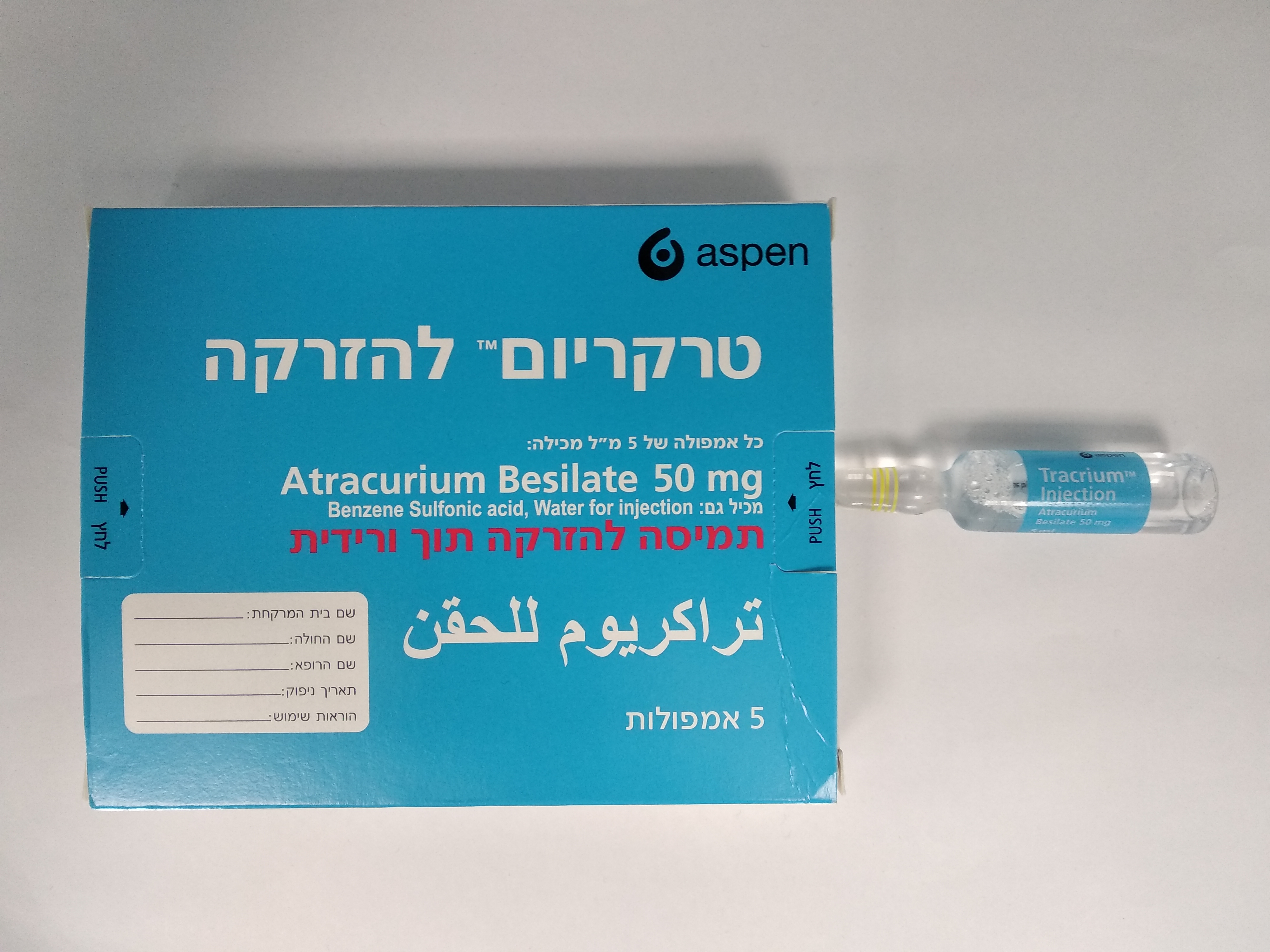Quest for the right Drug

טרקריום להזרקה TRACRIUM INJECTION (ATRACURIUM BESYLATE)
תרופה במרשם
תרופה בסל
נרקוטיקה
ציטוטוקסיקה
צורת מתן:
תוך-ורידי : I.V
צורת מינון:
תמיסה להזרקה : SOLUTION FOR INJECTION
עלון לרופא
מינוניםPosology התוויות
Indications תופעות לוואי
Adverse reactions התוויות נגד
Contraindications אינטראקציות
Interactions מינון יתר
Overdose הריון/הנקה
Pregnancy & Lactation אוכלוסיות מיוחדות
Special populations תכונות פרמקולוגיות
Pharmacological properties מידע רוקחי
Pharmaceutical particulars אזהרת שימוש
Special Warning עלון לרופא
Physicians Leaflet
Posology : מינונים
4.2 Posology and method of administration Route of administration: Intravenous injection or continuous infusion. Used by injection in adults: Tracrium is administered by intravenous injection. The dosage range recommended for adults is 0.3 to 0.6 mg/kg (depending on the duration of full block required) and will provide adequate relaxation for about 15 to 35 minutes. Endotracheal intubation can usually be accomplished within 90 seconds from the intravenous injection of 0.5 to 0.6 mg/kg. Full block can be prolonged with supplementary doses of 0.1 to 0.2 mg/kg as required. Successive supplementary dosing does not give rise to accumulation of neuromuscular blocking effect. Spontaneous recovery from the end of full block occurs in about 35 minutes as measured by the restoration of the tetanic response to 95% of normal neuromuscular function. The neuromuscular block produced by Tracrium can be rapidly reversed by standard doses of anticholinesterase agents, such as neostigmine and edrophonium, accompanied or preceded by atropine, with no evidence of recurarisation. Use as an infusion in adults: After an initial bolus dose of 0.3 to 0.6 mg/kg, Tracrium can be used to maintain neuromuscular block during long surgical procedures by administration as a continuous infusion at rates of 0.3 to 0.6 mg/kg/hour. Tracrium can be administered by infusion during cardiopulmonary bypass surgery at the recommended infusion rates. Induced hypothermia to a body temperature of 25o to 26oC reduces the rate of inactivation of atracurium, therefore full neuromuscular block may be maintained by approximately half the original infusion rate at these low temperatures. Tracrium is compatible with the following infusion solutions for the times stated below: Period of Infusion solution stability Sodium Chloride Intravenous Infusion British 24 hours Pharmacopoeia (BP) (0.9% w/v) Glucose Intravenous Infusion BP (5% w/v) 8 hours Ringer's Injection United States Pharmacopoeia (USP) 8 hours Sodium Chloride (0.18%w/v) and Glucose (4% w/v) 8 hours Intravenous Infusion BP Compound Sodium Lactate Intravenous Infusion BP 4 hours (Hartmann's Solution for Injection) When diluted in these solutions to give atracurium besilate concentrations of 0.5 mg/ml and above, the resultant solutions will be stable in daylight for the stated periods at temperatures of up to 30oC. Use in Children: The dosage in children over the age of one month is similar to that in adults on a bodyweight basis. Use in Neonates: The use of Tracrium is not recommended in neonates since there are insufficient data available (see section 5.1). Use in the elderly: Tracrium may be used at standard dosage in elderly patients. It is recommended, however, that the initial dose be at the lower end of the range and that it be administered slowly. Use in patients with reduced renal and/or hepatic function: Tracrium may be used at standard dosage at all levels of renal or hepatic function, including end stage failure. Use in patients with cardiovascular disease: In patients with clinically significant cardiovascular disease, the initial dose of Tracrium should be administered over a period of 60 seconds. Use in intensive care unit (ICU) patients: After an optional initial bolus dose of Tracrium of 0.3 to 0.6 mg/kg, Tracrium can be used to maintain neuromuscular block by administering a continuous infusion at rates of between 11 and 13 micrograms/kg/min (0.65 to 0.78 mg/kg/hr). There may be wide inter- patient variability in dosage requirements and these may increase or decrease with time. Infusion rates as low as 4.5 microgram/kg/min (0.27 mg/kg/hr) or as high as 29.5 microgram/kg/min (1.77 mg/kg/hr) are required in some patients. The rate of spontaneous recovery from neuromuscular block after infusion of Tracrium in ICU patients is independent of the duration of administration. Spontaneous recovery to a train-of-four ratio >0.75 (the ratio of the height of the fourth to the first twitch in a train-of-four) can be expected to occur in approximately 60 minutes. A range of 32 to 108 minutes has been observed in clinical trials. Monitoring: In common with all neuromuscular blocking agents, monitoring of neuromuscular function is recommended during the use of Tracrium in order to individualise dosage requirements.

שימוש לפי פנקס קופ''ח כללית 1994
לא צוין
תאריך הכללה מקורי בסל
01/01/1995
הגבלות
תרופה מוגבלת לשימוש בבתי חולים או אשפוז יום
מידע נוסף
עלון מידע לרופא
19.10.20 - עלון לרופאעלון מידע לצרכן
12.06.13 - עלון לצרכןלתרופה במאגר משרד הבריאות
טרקריום להזרקה